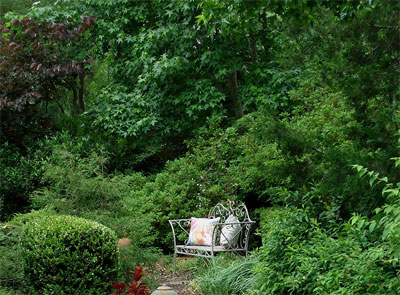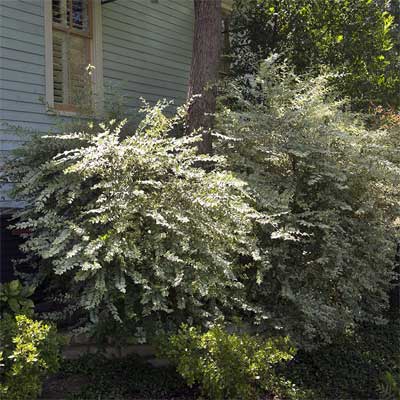From the Magazine: Living Screens

A permanent backdrop of junipers, azaleas and sweetspire provides complete privacy from the road behind.
Beautiful, Practical, Living Screens
Plantings to create barriers, block views and increase privacy
by Sharon Lee Smith
Do you have a need for privacy or windbreaks in particular areas of your landscape? Do you desire a graceful transition or a defined partition from one area of your garden to another? Maybe you are simply trying to perfect the view. Evergreen shrubs are a valuable solution to use as living fences or to screen unsightly views. These plants are anchors of the landscape and long-term investments. Careful selection for size, shape and permanence is essential. Consider evergreens with beautiful foliage, attractive flowers, berries or fragrance as you research which plants are best. Fortunately, the climate we live in allows us to select from a large variety of sturdy shrubs.

Shrubs like this variegated privet can effectively screen air-conditioning units or other mechanical elements.
The most important factor in choosing the shrubs for your living screen is the mature size needed for the space. It is best to plant shrubs that fit the space, instead of trying to keep larger shrubs pruned back. Trimming involves more work, and eventually the shrubs lose their natural shape. It is tempting to place shrubs closer together when planting in order to reach your privacy goal faster, but the lack of sunlight at the bottom of crowded plants can cause them to become sparse and lose lower foliage.
How quickly the screen must become established will influence your evergreen shrub selection. Growth rate varies among different shrubs, some growing quickly and others limping along. Be sure to tell your nurseryman your particular needs so the best selection is possible.

Waxleaf ligustrum has been a longtime favorite screening shrub in Texas gardens.
How dense your screen needs to be is another factor affecting plant selection. Are you seeking privacy or structural definition? Shrubs like hollies are so full you cannot see through them, while loropetalums allow light and air to flow freely. One trick for planting, if you have room, is to stagger the plants instead of planting them in a straight row. It leaves space between the shrubs but still blocks the view and provides a more natural appearance.
Ornamental factors to consider are flowers, fragrance, foliage color and berries. Blooming evergreens are always a welcome addition. The foliage of brightly colored or variegated shrubs can be as interesting as flowers, and the effect is year-round. Fragrance can be a bonus in the landscape, especially near patios or entrances. How lovely to arrive home and be greeted by the scent of sweet olive or gardenia! Berries are important to wildlife. If you enjoy bird watching, it is nice to plant shrubs that feed the birds.
Other things to consider are drainage, amount of available sunlight and water requirements. By observing your garden conditions, you will be better able to select the right plants for your landscape. Proper plant selection ensures the shrubs you pick will provide satisfaction for years to come.
Good Shrubs for Screening
Cherry Laurel (Prunus caroliniana): 15 to 20 feet with white blooms in spring.
Chinese Fringe Shrub (Loropetalum chinese): 6 to 15 feet depending on variety; most have burgundy foliage and fuchsia flowers fall and spring.
Gardenia (Gardenia jasminoides): 6 to 8 feet with white flowers spring and fall, depending on variety.
Holly ‘Nellie R. Stevens’ (Ilex X): 15 to 20 feet with rich green foliage and red winter berries.
Yaupon Holly (Ilex vomitoria): 15 feet with red winter berries and good drought tolerance.
Indian Hawthorn ‘Majestic Beauty’ (Rhaphiolepsis indica): 18-20 feet with hugh clusters of pink flowers spring and fall.
Eastern Redcedar (Juniperus virginiana): 30 to 40 feet with rich green, dense foliage.
Southern Wax Myrtle (Myrica cerifera): 15 to 20 fee with scented foliage and purple winter berries.
Sweet Olive (Osmanthus fragrans): 12 to 15 feet with fragrant white flowers fall through spring in mild weather.
Variegated Pittosporum (Pittosporum tobira): 8 to 10 feet with variegated foliage; perfect for partially shaded locations.
Variegated Privet (Ligustrum japonicum): 10 x 6 feet with variegated foliage and great drought tolerance.

